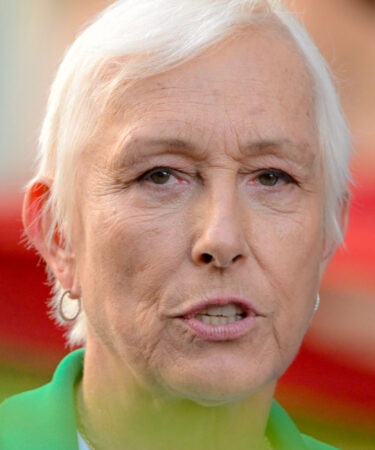November 3, 1975: The day the first ever WTA rankings were released
Every day Tennis Majors takes you back in time to celebrate a landmark moment in tennis history. Today, we go back to 1975 to witness how Chris Evert became the first player ever to sit on top of the WTA computer rankings
 Chris Evert_OTD_1973
Image Credit: © Panoramic / Tennis Majors
Chris Evert_OTD_1973
Image Credit: © Panoramic / Tennis Majors
What exactly happened on that day?
On this day, November 3,1975, four years after the group of women known as the “Original 9” began the first women’s professional tour (the Virginia Slims series), the Women’s Tennis Association (WTA) released the first computer-based world rankings. Without any surprises, Chris Evert, who had been dominating the game since 1974, was the first player to appear on top of this ranking.
The players involved: Chris Evert
- Chris Evert: The 20-year-old queen of women’s tennis

Chris Evert was born in 1954 in Florida, United States. Coached by her father, she developed a game based on consistency, keeping her opponents away from the net with her deep groundstrokes, and punishing them with great passing shots if they came in on an average shot. She obtained her first major result at the age of 16, reaching the US Open semi-final in 1971 (defeated by world No 1, Billie Jean King, 6-3, 6-2).
In 1973, at the age of 18, she finished runner-up at both Roland-Garros and Wimbledon, beaten by the two best players in the world, King and Margaret Court.
Evert started 1974 with another loss in a Grand Slam final, defeated by Evonne Goolagong in Australia (7-6, 4-6, 6-0). A few months later, she broke through by winning at Roland-Garros for the first time, routing Olga Morozova in the final (6-1, 6-2). This first Grand Slam title was soon followed by a second one, at Wimbledon (beating Morozova again, 6-0, 6-4), and in 1975, she added two more major titles to her list of achievements, winning at Roland-Garros and the US Open.
The facts: Chris Evert’s 15 titles earned her the top ranking in 1975
In 1975, five years had passed since the “Original 9” (Peaches Bartkowicz, Rosie Casals, Julie Heldman, Billie Jean King, Kristy Pigeon, Nancy Richey, Valery Ziegenfuss, Judy Dalton and Kerry Melville Reid) had established the first women’s professional tour, the Virginia Slims Circuit, sponsored by a tobacco company.
“We just knew we had the dream, the vision”, Billie Jean King would later explain. “We wanted every little girl in the world to have the opportunity to play and if she was good enough, to make a living from tennis.”
The “Original 9” traveled together from town to town to attend the first Virginia Slims events, and were all involved in the tour’s organisation, from marketing to selling tickets in front of supermarkets. “I got to understand very quickly what it took to put a tournament together from the ground up,” King would explain.
Since then, despite the growth of tennis as a sport, the progression of the women’s tour had it’s own ups and downs. After the creation of the Virginia Slims series, the USLTA, whose president Alastair Martin had strongly discouraged Billie Jean King to go ahead with her project, set up its own circuit.
“Can you imagine, after two years of pleading with them behind the scenes?”, King would recall 50 years later on the WTA website. “So, we have a tour and – oh, no – now there are two tours. It divided the players, which was the worst thing that could have happened.”
It was not before 1973 that female players were united in one single association, the Women’s Tennis Association (WTA) – the same year that King defeated Bobby Riggs in the Battle of the Sexes. At the following US Open, women obtained equal prize in a Grand Slam tournament for the first time. The WTA was born in London, the week before Wimbledon, when more than 60 players met at the Gloucester Hotel.
In 1974, the decision was made to establish a computer-based ranking, similar to the one used on the men’s tour since 1973.
“Before the computer rankings, what they did was rank you at the end of the year, and I was No 1 in 1974, probably because of the French Open and Wimbledon,” Chris Evert would recall, according to Tennis.com. “When the computer rankings came out, it was explained primarily as a basis for getting into tournaments, seedings, cut-offs, but the players already knew who was No 1 or No 2. It just legitimized everything on paper.”
At the start of November 1975, Evert had won no less than 15 tournaments since the beginning of the year, including Roland-Garros and the US Open. Therefore, it came as no surprise to see her on top of the first computerised WTA rankings ever released on November 3, 1975.
The first-ever top 10 WTA rankings were as follows:
- Chris Evert
- Virginia Wade
- Martina Navratilova
- Billie Jean King
- Evonne Goolagong
- Margaret Court
- Olga Morozova
- Nancy Riche
- Francoise Durr
- Kerry Melville Reid
Being the first on this prestigious list was highly satisfying for Evert.
“It gave me pride, a sense of accomplishment, confidence – it was a really nice feeling. That’s where you want to be. Anybody would love to become No. 1 and it’s a goal that very few people achieve.”
What next? Evert spends 260 weeks atop the WTA rankings
Chris Evert would remain world No 1 for the next 140 weeks (although two of these weeks would be later retrospectively granted to Evonne Goolagong, 30 years later) and 260 weeks in total. She would appear at the top of the WTA rankings for the last time in November 1985.
46 years after the first-ever WTA rankings were published, a total of 29 women would have managed to reach the pinnacle of their sport (the dates mentioned below are the first date the player reached the world No 1 ranking).
- Chris Evert (November 3, 1975)
- Evonne Goolagong (April 26, 1976, granted retrospectively in 2007)
- Martina Navratilova (July 10, 1978)
- Tracy Austin (April 7, 1980)
- Steffi Graf (August 17, 1987)
- Monica Seles (March 11, 1991)
- Arantxa Sanchez-Vicario (February 6, 1995)
- Martina Hingis (March 31, 1997)
- Lindsay Davenprt (October 12, 1998)
- Jennifer Capriati (October 15, 2001)
- Venus Williams (February 25, 2002)
- Serena Williams (July 8, 2002)
- Kim Clijsters (August 11, 2003)
- Justine Henin (October 20, 2003)
- Amélie Mauresmo (September 13, 2004)
- Maria Sharapova (August 22, 2005)
- Ana Ivanovic (June 9, 2008)
- Jelena Jankovic (August 11, 2008)
- Dinara Safina (April 20, 2009)
- Caroline Wozniacki (October 11, 2010)
- Viktoria Azarenka (January 30, 2012)
- Angelique Kerber (September 12, 2016)
- Karolina Pliskova (July 17, 2017)
- Garbine Muguruza (September 11, 2017)
- Simona Halep (October 9, 2017)
- Naomi Osaka (January 28, 2019)
- Ashleigh Barty (June 24, 2019)
- Iga Swiatek (April 4, 2022)
- Aryna Sabalenka (September 11, 2023)
Here’s a few of the main records established on the WTA tour:
- Most weeks spent as world No 1:
- Steffi Graf, 377 weeks
- Martina Navratilova, 332 weeks
- Serena Williams, 319 weeks
- Chris Evert, 260 weeks
- Martina Hingis, 209 weeks
- Longest uninterrupted reign: Steffi Graf & Serena Williams, 186 weeks
- Youngest player to reach world No 1: Martina Hingis, 16 years and 152 days, in 1997
- Oldest player to become world No 1: Serena Williams, 35 years and 8 months, in 2017













